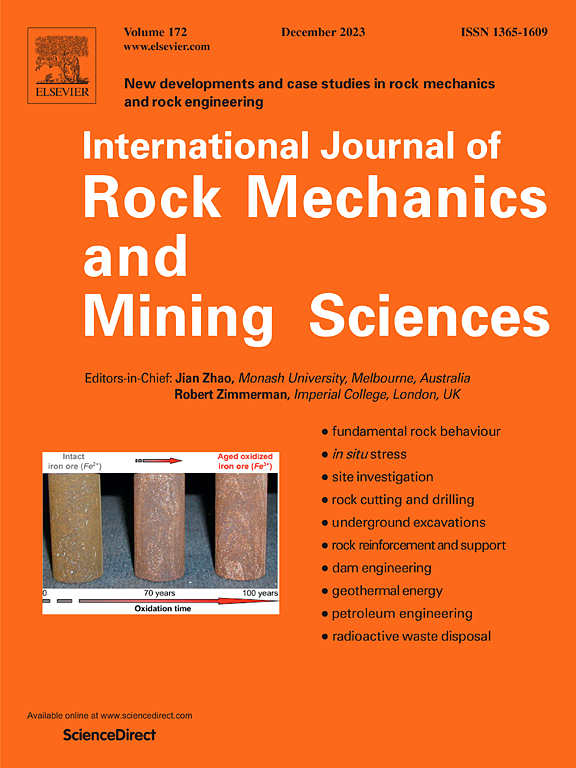An experimental investigation on the dynamic shear characteristics of wet joints
IF 7.5
1区 工程技术
Q1 ENGINEERING, GEOLOGICAL
International Journal of Rock Mechanics and Mining Sciences
Pub Date : 2025-07-22
DOI:10.1016/j.ijrmms.2025.106193
引用次数: 0
Abstract
This study investigated the dynamic shear behavior of planar granite joints under dry and wet conditions using the impact-induced direct shear test. The effects of shear rate and normal stress on the dynamic shear properties were examined on dry and wet joints under four different normal stress conditions. Dynamic shear stress and shear displacement were measured by stress wave acquisition and digital image correlation method, respectively. Dynamic friction coefficients were calculated using the Mohr-Coulomb criterion. Additionally, fracture energy was calculated and compared with nano-indentation tests. The results revealed that moisture significantly alters the dynamic shear response of rock joints. Although both dry and wet joints exhibited dynamic shear stress–displacement curves consisting of two stages, namely a shear stress accumulation stage and a slip stage, the wet joints displayed notably greater strength degradation. A linearly decreasing relationship between maximum shear displacement and normal stress was observed for both joint types. Within the shear displacement rate range of 4–6 m/s, both dry and wet joints exhibited a negative rate effect, wherein dynamic shear strength decreases with increasing shear rate. Wet joints showed a significant 53.2 % reduction in dynamic friction coefficient, compared to 33.9 % for dry joints. Nano-indentation tests further revealed differences in microscale mechanical behavior between dry and wet joints. Compared to dry joints, wet joints showed a 74.2 % increase in maximum indentation depth and a 50.69 % reduction in fracture energy. These findings suggest that wetting-induced strength weakening of rock joints was governed by reductions in fracture energy and frictional properties.
湿节理动剪特性试验研究
采用冲击直剪试验研究了平面花岗岩节理在干湿两种条件下的动剪特性。在4种不同的法向应力条件下,研究了剪切速率和正应力对干湿节理动剪性能的影响。采用应力波采集法和数字图像相关法分别测量动剪应力和剪切位移。采用Mohr-Coulomb准则计算动力摩擦系数。计算了断裂能,并与纳米压痕试验进行了对比。结果表明,水分对岩石节理的动剪响应有显著影响。干节理和湿节理的动态剪应力-位移曲线均表现为剪应力积累阶段和滑移阶段,但湿节理的强度退化程度更大。两种节理的最大剪切位移与正应力均呈线性递减关系。在4 ~ 6 m/s剪切位移速率范围内,干、湿节理均表现为负速率效应,动抗剪强度随剪切速率的增加而降低。湿接缝的动态摩擦系数显著降低53.2%,而干接缝的动态摩擦系数降低33.9%。纳米压痕试验进一步揭示了干湿接缝微观力学行为的差异。与干接头相比,湿接头最大压痕深度增加74.2%,断裂能降低50.69%。这些发现表明,岩石节理的润湿强度减弱是由断裂能和摩擦特性的降低所控制的。
本文章由计算机程序翻译,如有差异,请以英文原文为准。
求助全文
约1分钟内获得全文
求助全文
来源期刊
CiteScore
14.00
自引率
5.60%
发文量
196
审稿时长
18 weeks
期刊介绍:
The International Journal of Rock Mechanics and Mining Sciences focuses on original research, new developments, site measurements, and case studies within the fields of rock mechanics and rock engineering. Serving as an international platform, it showcases high-quality papers addressing rock mechanics and the application of its principles and techniques in mining and civil engineering projects situated on or within rock masses. These projects encompass a wide range, including slopes, open-pit mines, quarries, shafts, tunnels, caverns, underground mines, metro systems, dams, hydro-electric stations, geothermal energy, petroleum engineering, and radioactive waste disposal. The journal welcomes submissions on various topics, with particular interest in theoretical advancements, analytical and numerical methods, rock testing, site investigation, and case studies.

 求助内容:
求助内容: 应助结果提醒方式:
应助结果提醒方式:


